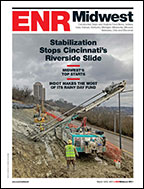
Investigators looking into the cause of a non-fatal construction collapse of a casino floor in Cincinnati in late January and a casino garage deck in Cleveland in late December are searching for common clues, while contractors have added quality controls for extra safety.
The developer of both casinos, a joint venture between Rock Gaming LLC and Caesars Entertainment Inc., insists the accidents are not linked. "These are two different construction management companies, two different contractors, two different sites, two different areas," Steve Rosenthal, manager of the $400-million, 354,000-sq-ft Horseshoe Casino in Cincinatti, told television news after the Jan. 27 collapse. "There is absolutely nothing in common with the two different sites."
The Cincinnati collapse injured 13 workers; one remains hospitalized.
Investigators with the U.S. Occupational Safety and Health Administration "don't have any details to report on either [accident] yet, but I'm sure OSHA is going to compare the two and see if there is anything similar," says Scott Allen, an OSHA spokesman in Chicago.
The projects, whose budgets are valued at a combined $1 billion, use different structural systems. The Cleveland garage is made of reinforced concrete, while the Cincinnati building is supported by a steel frame. Both projects have resumed work and are still on schedule to open in March 2012 and spring 2013, respectively.
Engineers say that, in the Cincinnati structure, bolts likely failed; a 60-ft-sq bay on the second floor, constructed of steel beams supporting metal decking, collapsed in a V-shape as concrete workers continued a morning pour that started in an adjacent bay. The metal deck and supporting beams fell without warning, taking the workers for a 25-ft ride.
Since the accident occurred, the construction manager, Messer Construction Co., has hired a steel inspector and a second full-time on-site safety manager.
Messer also has offered to torque down all bolted connections before pouring any concrete—an extra step that is not always common in the trade but "will obviously provide a margin of safety," says Amit Ghosh, Cincinnati's chief building official. Bolts often are not tightened until a building nears completion.
Investigators will likely look at how the steel went up and how the metal deck was supported, says Steven Smith, vice president of forensic firm CTLGroup. "It's fairly extreme for an entire bay to fall down with all the framing," Smith says.
Messer would not comment on causes, but Ghosh says, "All the beams attached to the main beam at the midspan— those connections were broken." Codes do not specify when connections are to be made permanent, but "these types of accidents probably are preventable," he adds.



Post a comment to this article
Report Abusive Comment